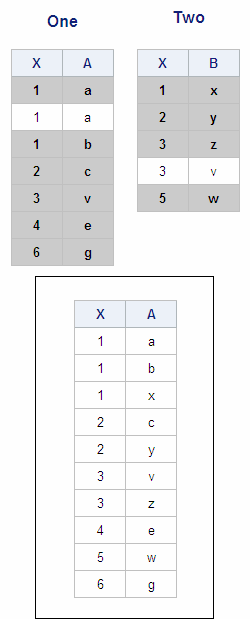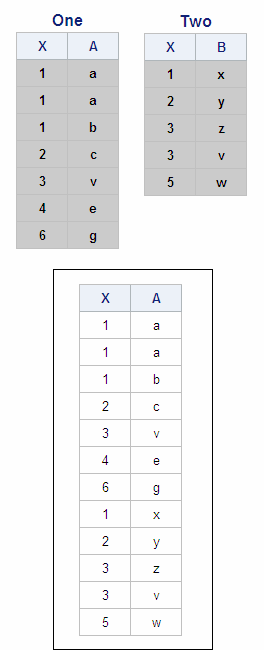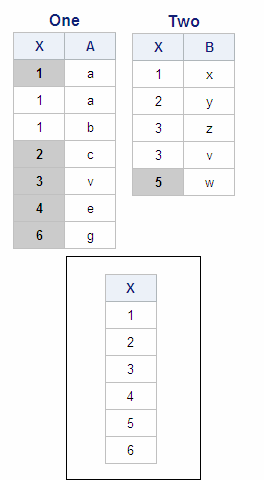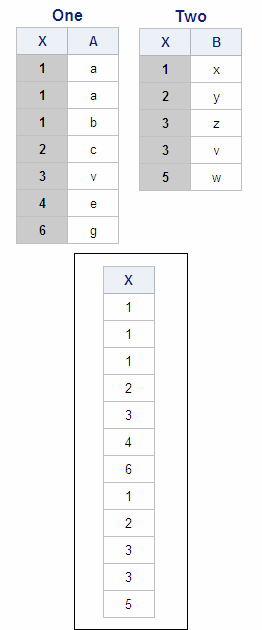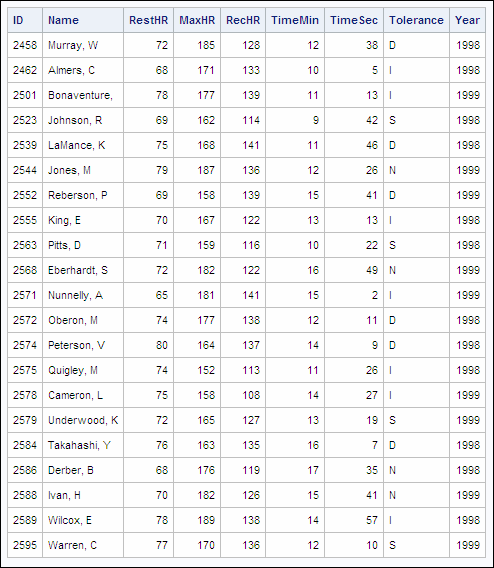Using the UNION Set Operator
Using the UNION Operator Alone
To display all rows
from the tables One and Two that are unique in the combined set of
rows from both tables, use a PROC SQL set operation that includes
the UNION operator:
With the UNION operator,
PROC SQL first concatenates and sorts the rows from the two tables,
and eliminates any duplicate rows. In this example, two rows are eliminated:
the second row in table One is a duplicate of the first row, and the
fourth row in table Two matches the fifth row in table One. All remaining
rows, the unique rows, are included in the output. The columns are
overlaid by position.
Using the Keyword ALL with the UNION Operator
When the keyword ALL is added to the UNION operator,
the output displays all rows from both tables, both unique and duplicate.
The modified PROC SQL set operation, the tables One and Two, and the
new output are shown below:
When the ALL keyword
is used, PROC SQL does not remove duplicates or sort the rows. The
output now includes the two duplicate rows that were eliminated in
the previous example: the second row in table One and the fourth row
in table Two. Note that the rows are in a different order in this
output than they were in the output from the previous set operation.
Using the Keyword CORR with the UNION Operator
To display all rows from the tables One and Two that
are unique in the combined set of rows from both tables, based on
columns that have the same name rather than the same position, add
the keyword CORR after the set operator. The modified query, the tables
One and Two, and the output are shown below:
X is the only column
name that is common to both tables, so X is the only column that PROC
SQL examines and displays in the output. In the combined set of rows
from the two tables, there are duplicates of the values 1, 2, and
3, and these duplicate rows are eliminated from the output. The output
displays the six unique values of X.
Using the Keywords ALL and CORR with the UNION Operator
Example: UNION Operator
The UNION operator can
be used to solve a realistic business problem. Suppose you are generating
a report based on data from a health clinic. You want to display the
results of individual patient stress tests taken in 1998, followed
by the results from stress tests taken in 1999. To do this, you use
the UNION operator to combine the tables Sasuser.Stress98 and Sasuser.Stress99.
These two tables are similar in structure:
-
both tables contain nine columns that have the same names
-
each row contains data for an individual patient.
You are not sure whether
the tables contain duplicate records, but you do not want duplicates
in your output. Because the tables have the same column structure,
you can overlay the columns by position, and the CORR keyword is not
necessary. The PROC SQL set operation and output are shown below (the
rows are ordered by IDs.):
Tip
If you can determine that
these tables have no duplicate records, you could add the keyword
ALL to speed up processing by avoiding an extra pass through the data.
Example: UNION Operator and Summary Functions
We can demonstrate another
realistic business problem, to see how summary functions can be used
with a set operator (in this case, UNION). Suppose you want to display
the following summarized data for members of a frequent-flyer program:
total points earned, total points used, and total miles traveled.
All three values can be calculated from columns in the table Sasuser.Frequentflyers
by using summary functions.
You might wonder why
set operations are needed when only one table is involved. If you
wanted to display the three summarized values horizontally, in three
separate columns, you could solve the problem without a set operation,
using the following simple SELECT statement:
proc sql;
select sum(pointsearned) format=comma12.
label='Total Points Earned',
sum(pointsused) format=comma12.
label='Total Points Used',
sum(milestraveled) format=comma12.
label='Total Miles Traveled'
from sasuser.frequentflyers;Assume, however, that
you want the three values to be displayed vertically in a single column.
To generate this output, you create three different queries on the
same table, and then use two UNION set operators to combine the three
query results:
proc sql;
title 'Points and Miles Traveled';
title2 'by Frequent Flyers';
select 'Total Points Traveled:',
sum(MilesTraveled) format=comma12.
from sasuser.frequentflyers
union
select 'Total Points Earned:',
sum(PointsEarned) format=comma12.
from sasuser.frequentflyers
union
select 'Total Points Used:',
sum(PointsUsed) format=comma12.
from sasuser.frequentflyers;Each SELECT clause defines
two columns: a character constant as a label and the summarized value.
The output is shown below.
Note: The preceding program reads
the same table three times, so it is not the most efficient way to
solve this problem.
..................Content has been hidden....................
You can't read the all page of ebook, please click here login for view all page.


